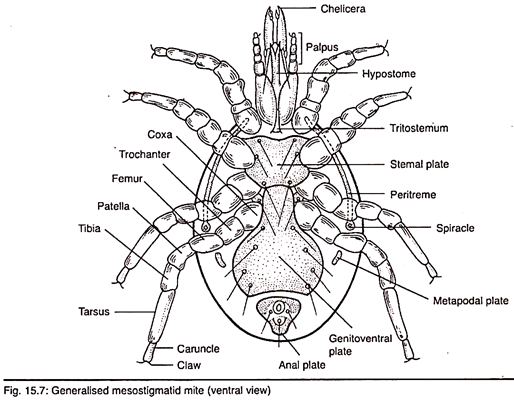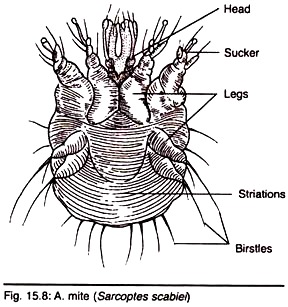ADVERTISEMENTS:
In this article we will discuss about the mites and ticks as vectors.
1. Mites:
Mites surpass all other Arachnids in numbers and they are very small sized Acarines. There is a great variety of body form in the Acarina, some appearing grotesque. The majority are more or less round or oval without division into head, thorax and abdomen, but some have a suture dividing the body into anterior and posterior division, though in some it may be elongated.
The body is covered with tactile hairs or scales. There is no true head, but the mouth parts are borne on an anterior part, called a gnathosoma or capitulum. Eyes may be present or absent. There are two pairs of mouth parts, the chelicerae and the pedipalps or palpi.
ADVERTISEMENTS:
The chelicerae consist of a movable and an immovable digit and are modified for piercing and sucking—whereas the palps usually consist of 4-6 segments, sometimes modified as a thumb-and-claw. Acarines usually consist of 4 pairs of legs, but only 1-3 pairs may be present in some species of mites. Segments of legs are like those of ticks. The anus opens on the ventral surface of the abdomen but the position of gonopore is variable.
There are usually four stages in the development (i.e. life history) of mites—egg, larva, nymph and adult. However, there are usually a single larval stage and two nymphal stages (i.e., the protonymph and deutonymph) in the life cycle of a mite. The number of nymphal generation may be less or more in some species of mites.
Many mites are free living, some are predaceous and many are parasitic on other animals during all or part of their life cycle. Some of these rank among the most important disease vectors and some act as intermediate hosts of Protozoans or Helminths.
General Idea about Mites as Vectors:
There are some species of mites which are important from the stand point of veterinary science as they cause transmission of several diseases. There are also few species of mites which help in the transmission of human diseases including allergy.
ADVERTISEMENTS:
The important vector species of mites will be discussed:
1. Redbugs or Chigger mites:
There is probably no creature on earth that can cause more torment for its size than a red bug. In the Far East some species of Redbugs add injury to insult by transmitting a disease, scrub typhus. These mites are also suspected on epidemiological grounds of transmitting epidemic haemorrhagic fever. In Siberia, Korea, Manchuria scrub typhus is a viral disease which causes fever, kidney damage etc. and is fatal in 5% of cases.
The red bugs are the six-legged larvae of mites of the family Trombiculidae under order Prostimata, comprise a group of mites which are parasitic to human beings only at their larval stage. The nymphs and adults are free living, feeding on insect eggs or minute insect larvae. The important chigger mite, Trombicula akamushi is responsible for causing scrub typhus to human beings but T. pelkini, T. goldii, T. wichtnanni etc. create human dermatitis.
The larval mite acts as the vector in carrying the pathogen, Rickettsia tsutsugamushi causing scrub typhus. They transmit the pathogen from small mammals to human beings (hosts). The larval mites receive the pathogens by means of transovarian transmission from the mother.
Now the larvae penetrate the epidermis by means of mouth parts and introduce the salivary secretion containing the pathogen into the host. The Escher is the primary lesion which appears just at the point of red-bug bite.
It is characterised by headache, apathy, fever, lymph adenitis, general malaise, enlarged spleen, deafness, nervous turbances etc. The Escher enlarges and becomes necrotic in the centre and red rashes appear on the trunk that may spread to extremities.
2. Itch and Eczema creating mites (Sarcoptes scabiei):
ADVERTISEMENTS:
The minute rounded or oval, short legged, flattened mites of the family Sarcoptidae under the suborder Sarcoptiformes are the cause of scabies or “itch” in man. This mite creates eczema and unbearable itches leading to mange of man.
The cuticle of the mite is delicately sculptured, number of bristles is few, eyes and trachea are absent. Capitulum is well developed. The legs are short and stumpy and are provided with sucker like adhesive pads (Fig. 15.9 and 15.10).
When the female mite, comes in contact with the hands or feet of human, it excavates thin tortuous tunnels in the epidermis. The tunnel measures a few mm to over an inch in length and is usually gray from the eggs and excrement deposited by the female as she burrows. The daily excavations of a mite is about 2-3 mm.
The life span of a mite is about 4 weeks and the young impregnated females make fresh excavations of their own and the process goes on. As a result the tissues below the epidermis are destroyed and finally itching begins. The itching is so severe that the patient cannot sleep at night and sometimes the infection becomes unbearable.
Repeated infection of itching turns into eczema. Sarcoptes scabiei generally invades the skin of the wrist though external genetalia, breasts, legs, thorax and other organs may be attacked by this mite.
ADVERTISEMENTS:
3. The Tropical rat mite:
The tropical rat mite, Ornithonyssus bacoti (formerly Liponyssus or Bdellonyssus) are important parasites of birds and rodents and are concerned in transmission of certain rickettsial and viral diseases. They have relatively narrow dorsal shields and chelicerae that end in pincers in both sexes.
They act as vectors of Q. fever by transmitting the pathogen, Coxiella bumetti. The blood sucking protonymph is the infective stage of the disease. This tropical rat mite plays a minor role in transmission among reservoir hosts, and occasionally to human beings, of endemic typhus, rickettsialpox, Q. fever, plague, etc. and it also acts as the intermediate host of the filaria of cotton rats, Liptomosoides.
2. Ticks:
Ticks are large mites with leathery skin and in general ticks are parasites of animals. All of them feed on vertebrate blood. Most species have a long life span, may be 5 years or more. The reproductive potential is high. Some species may deposit as many as 18,000 eggs (Fig. 15.11).
The body of tick is segmented and is divisible into two regions—the capitulum and the body proper. Capitulum is not the true head though it is commonly referred to as such. The capitulum is movable having rostrum enclosing toothed chelicerae and toothed hypostome. A pair of pelpi or pedipalpi arise from the anteroventral margin of the capitulum. There are 4 pairs of prominent, slender 6-jointed legs with two claws and pad.
On the basis of the difference present in body proper, they are broadly classified into two groups as soft ticks and hard ticks. Soft ticks belong to the family Argasidae while those belong to the family Ixodidae are known as hard ticks.
The basic characters of soft and hard ticks are more or less same but there are many distinguishing features which are tabulated below:
Role of Ticks as Transmitters of Disease:
Ticks play an important role as vectors of disease to domestic animals and to somewhat less extent to man.
They transmit six principal types of organisms of diseases, as:
ADVERTISEMENTS:
(i) Spirochaetes of relapsing fever,
(ii) Rickettsias of spotted fever;
(iii) Babesiidae,
(iv) Pasteurella tularensis, the bacterium of tularemia,
(v) Anaplasma and
(vi) Filtrable virus and encephalomyelitis virus.
ADVERTISEMENTS:
Many soft and hard ticks harbour and transmit a bacilli of the genus Salmonella which cause para-typhoid like disease in rodents. Species of Ornithodoros can also harbour and transmit Leptospiras. One of the most dreaded tick of this genus is O. moubata which is the vector for Spirochaeta duttoni, the pathogen that causes African relapsing fever. The infection is transmitted by the bite of both male and female ticks during all their active stages.
The attack of relapsing fever in human takes place from 5 to 10 days after the tick has bitten. O. moubata appears to be essentially a parasite of human being. It is a man- to tick-to man vector of relapsing fever. Once the Spirochaeta duttoni, the pathogens are ingested by the ticks, they penetrate the stomach wall to reach the body cavity where they multiply. Then the pathogens invade the salivary and coxal glands of the ticks.
The pathogens are transmitted to the man by both the sexes of ticks. Infection starts by the injection into the host’s skin of the Spirochaetes (pathogens) along with the saliva and coxal fluid of the ticks. Once infected, the ticks remain so, and the infection may be transmitted from generation to generation.
In addition to Rocky mountain fever, the tick Dermacentor andersoni also acts as the vector for several human diseases like Indian tick typhus, Colorado tick fever, Tick paralysis, Powassan encephalites etc. In Rocky mountain fever the infection is acquired from the reservoir animals by a feeding tick, Dermacentor andersoni in any stage of its life history and is passed on from stage to stage.
For example the pathogen, Rickettsia rickettsii infected blood is ingested by the larva, the infection is transferred into nymph and then to the adult which in turn may infect. It has been reported that some infected adult females will pass the pathogen through their eggs to the larvae of the next generation. The pathogen of this Rocky mountain fever is transferred to the host through saliva of the tick while biting.
Control of Ticks and Mites:
In general ticks and mites can be controlled by the following methods:
A. General control:
It is of three kinds:
1. Insecticidal control:
The ticks and mites can be destroyed by dusting or spraying of insecticides like malathion, lindane, chlorodane at rates of 0.5-1 kg per acre.
2. Environmental protection:
Before planning a control programme a thorough knowledge of the habit and habitats of ticks and mites must be gained. Animal hosts should be destroyed. The cracks and crevices in the field particularly near buildings should be reduced by filling.
3. Protection of workers:
Workers should be encouraged to wear protective clothing impregnated with an insect repellent, like benzyl benzoate, indalone or diethyltoluamide etc.
B. Specific control:
1. Chigger mite infestations in gardens, lawns and general premises can be utterly destroyed by applying suitable chemicals (chlorodane, toxaphen or lindane) either by a spraying method or by a dusting process to the infested areas.
2. Reproduction of rodents should be avoided.
3. Old tree snags in vicinity which may harbour nesting squirrels and chipmunks should not be encouraged.
C. Personal control:
1. To avoid the infected person and making arrangement for proper treatment.
2. Avoid sleeping in the same bed with the infected person.
3. Use Dettol soap during bathing.








